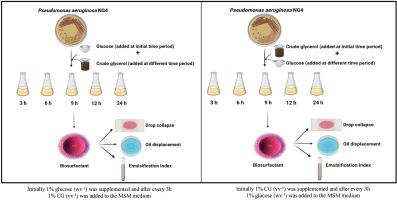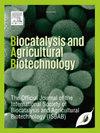铜绿假单胞菌 NG4 对底物的共代谢调节生物表面活性剂的生产
IF 3.4
Q2 BIOTECHNOLOGY & APPLIED MICROBIOLOGY
引用次数: 0
摘要
与化学表面活性剂相比,生物表面活性剂因其可降解性、稳定性和其他特殊的物理化学特性,在各行各业中发挥着更为重要的作用。通过 1%葡萄糖(wv-1)和 1%CG(vv-1)在不同时间间隔内的共代谢,研究了铜绿假单胞菌 NG4 产生生物表面活性剂的情况。在培养基中加入葡萄糖(0 小时)+ CG(24 小时)(1:1,wv-1,vv-1)后,生物表面活性剂的产量为 4.23 gL-1。产量提高了约 4.75 倍。饲料中培养 CG 的时间优化为葡萄糖开始发酵后的 24 小时。在本研究使用的几种氮源中,硝酸钠比其他氮源产生更多的生物表面活性剂。通过傅立叶变换红外光谱和液相色谱-质谱对生物表面活性剂进行生化鉴定,发现其中含有单鼠李糖脂和双鼠李糖脂。因此,本研究强调了铜绿微囊藻 NG4 通过共同利用底物来提高生物表面活性剂产量的能力。本文章由计算机程序翻译,如有差异,请以英文原文为准。

Co-metabolism of substrates by Pseudomonas aeruginosa NG4 regulates biosurfactant production
As compared to chemical surfactants, biosurfactants exhibit a more significant impact in various sectors due to their degradability, stability, and other specific physicochemical properties. Biosurfactant production by Pseudomonas aeruginosa NG4 was studied by co-metabolism of 1% glucose (wv−1) and 1% CG (vv−1) with different time intervals. The addition of Glucose (0h) + CG (24 h) (1:1, wv−1, vv−1) to the culture medium resulted in 4.23 gL-1 of biosurfactant production. An enhancement of about 4.75-fold in the yield was observed. The time period of incubation of CG in the feed was optimized to be 24 h after the initiation of fermentation with glucose. Among the several nitrogen sources used in this study, sodium nitrate produced more biosurfactant than the others. Biochemical characterization through FTIR and LC-MS of biosurfactant reflected the presence of mono- and di-rhamnolipids. Therefore, this study highlights the ability of P. aeruginosa NG4 to increase biosurfactant production by co-utilizing substrates.
求助全文
通过发布文献求助,成功后即可免费获取论文全文。
去求助
来源期刊

Biocatalysis and agricultural biotechnology
Agricultural and Biological Sciences-Agronomy and Crop Science
CiteScore
7.70
自引率
2.50%
发文量
308
审稿时长
48 days
期刊介绍:
Biocatalysis and Agricultural Biotechnology is the official journal of the International Society of Biocatalysis and Agricultural Biotechnology (ISBAB). The journal publishes high quality articles especially in the science and technology of biocatalysis, bioprocesses, agricultural biotechnology, biomedical biotechnology, and, if appropriate, from other related areas of biotechnology. The journal will publish peer-reviewed basic and applied research papers, authoritative reviews, and feature articles. The scope of the journal encompasses the research, industrial, and commercial aspects of biotechnology, including the areas of: biocatalysis; bioprocesses; food and agriculture; genetic engineering; molecular biology; healthcare and pharmaceuticals; biofuels; genomics; nanotechnology; environment and biodiversity; and bioremediation.
 求助内容:
求助内容: 应助结果提醒方式:
应助结果提醒方式:


